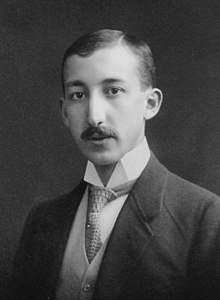
Back جورج هيفيشي Arabic جورج هيفيشى ARZ Georq de Xeveşi Azerbaijani قئورق دو هوسی AZB Дзьёрдзь дэ Хевешы Byelorussian Дьорд де Хевеши Bulgarian গেয়র্গ ডে হেভেসি Bengali/Bangla George de Hevesy Catalan George de Hevesy Czech George de Hevesy Danish
George de Hevesy | |
|---|---|
 | |
| Born | György Bischitz 1 August 1885 |
| Died | 5 July 1966 (aged 80) |
| Citizenship |
|
| Education | University of Budapest Technische Universität Berlin University of Freiburg |
| Known for | |
| Spouse |
Pia Riis (m. 1924) |
| Children | 4 |
| Parents |
|
| Awards | Nobel Prize for Chemistry (1943) Copley Medal (1949) Faraday Lectureship Prize (1950) Atoms for Peace Award (1958) Fellow of the Royal Society[1] |
| Scientific career | |
| Fields | Chemistry |
| Institutions | Ghent University University of Budapest Niels Bohr Institute ETH Zürich University of Freiburg University of Manchester Stefan Meyer Institute for Subatomic Physics |
| Doctoral advisor | Georg Franz Julius Meyer |
| Other academic advisors | Fritz Haber Ernest Rutherford |
| Doctoral students | Rolf Hosemann Johann Böhm |
| Other notable students | Erika Cremer (postdoc) |
George Charles de Hevesy (born György Bischitz; Hungarian: Hevesy György Károly; German: Georg Karl von Hevesy; 1 August 1885 – 5 July 1966) was a Hungarian radiochemist and Nobel Prize in Chemistry laureate, recognized in 1943 for his key role in the development of radioactive tracers to study chemical processes such as in the metabolism of animals. He also co-discovered the element hafnium.[1][2][3][4][5][6]
- ^ a b Cockcroft, J. D. (1967). "George de Hevesy 1885-1966". Biographical Memoirs of Fellows of the Royal Society. 13: 125–126. doi:10.1098/rsbm.1967.0007. S2CID 122095945.
- ^ Levi, H. (1976). "George von Hevesy memorial lecture. George Hevesy and his concept of radioactive indicators--in retrospect". European Journal of Nuclear Medicine. 1 (1): 3–10. doi:10.1007/BF00253259. PMID 797570. S2CID 6640231.
- ^ Ostrowski, W. (1968). "George Hevesy inventor of isotope methods in biochemical studies". Postepy Biochemii. 14 (1): 149–153. PMID 4870858.
- ^ Dal Santo, G. (1966). "Professor George C. De Hevesy. In reverent memory". Acta Isotopica. 6 (1): 5–8. PMID 4865432.
- ^ "George De Hevesy". Triangle; the Sandoz Journal of Medical Science. 91: 239–240. 1964. PMID 14184278.
- ^ Weintraub, B. (April 2005), "George de Hevesy: Hafnium and Radioactive Traces; Chemistry", Bull. Isr. Chem. Soc. (18): 41–43